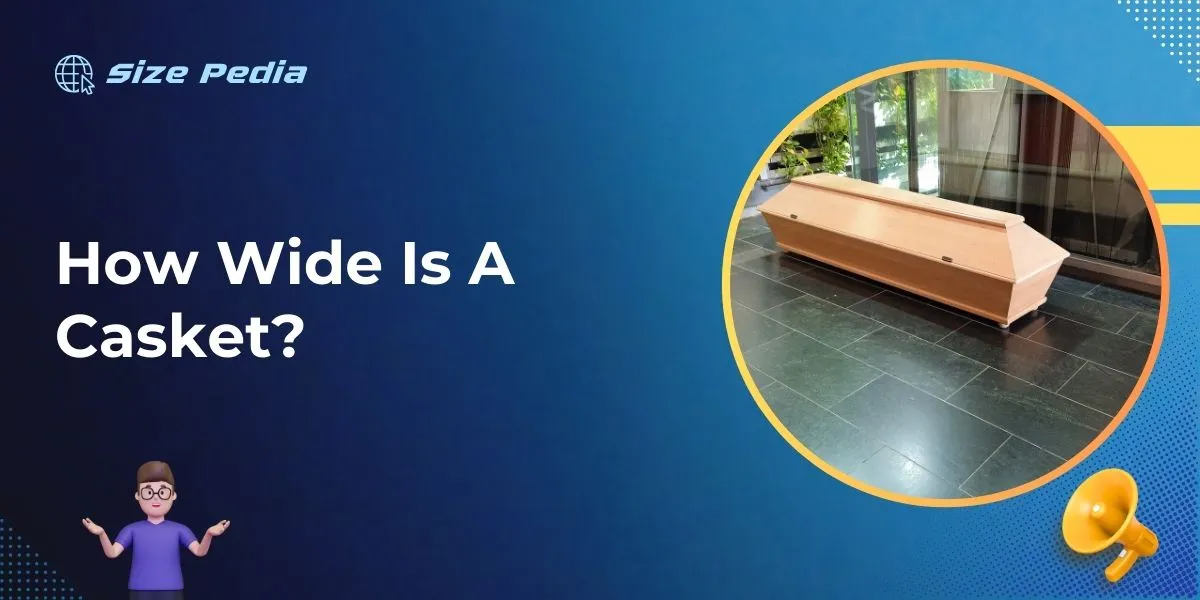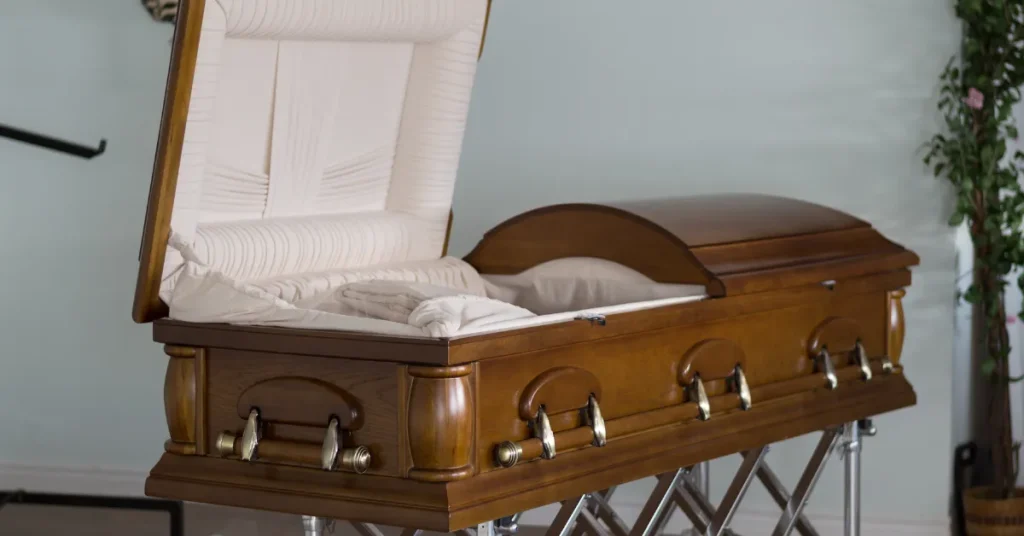The average width of a casket is 28 inches. Standard caskets are about 24 to 27 inches wide internally.
Selecting the proper casket size is essential for honoring a loved one’s final journey—this choice reflects personal preference, budget considerations, and the individual’s physical requirements.
Typically constructed from metal, wood, or other materials, caskets vary not only in width but also in length and depth, accommodating different body types and sizes.
It is important to consult with funeral directors, as they can provide guidance on the appropriate dimensions and styles available. Additionally, some cemeteries have regulations regarding casket sizes, which should be taken into account when making arrangements.
Remember, the right casket respectfully encapsulates a lifetime of memories and signifies the final care given to a loved one.

A Brief History Of Caskets And Their Evolution
The story of caskets is a tale rich in history and tradition. These final resting vessels have evolved throughout the ages to meet the needs and customs of different cultures.
The journey from ancient methods of interment to the modern caskets we know today reflects changes in society, technology, and design preferences.
From Ancient Times To The Present
Early burial practices often involved natural elements. Bodies wrapped in simple cloth or hides laid to rest within the earth. Over time, civilizations began constructing wooden coffins to offer a distinguished passage to the afterlife.
The Egyptians crafted elaborate sarcophagi to protect and honor the dead. The use of caskets spread across continents, adapting to reflect local customs and availability of materials.
Influences On Casket Design And Dimensions
The design and size of caskets mirror the societal values and technological advancements of their times. Wealth and social status often dictated the opulence of a casket.
Wood varieties, metal accents, and interior linings evolved as markers of luxury and respect. Casket dimensions grew with the consideration of comfort and aesthetics.
- Material Scarcity: Wood types and metal availability shaped design choices.
- Cultural Significance: Symbolic elements included to honor the deceased.
- Technological Progress: Modern manufacturing allowed for uniform sizes and shapes.
Standard Casket Dimensions
Understanding the standard casket dimensions is critical, especially during the emotional time of choosing a final resting place for a loved one.
These dimensions play a vital role in ensuring a proper fit for transportation and burial. Below, we delve into the standard sizes for the interior and exterior of a casket.
Interior Width
The interior width of a casket is a key measurement. It’s the space where the body rests. Most standard adult caskets have an interior width of 24 inches. This comfortably accommodates individuals of average size. Some caskets, known as oversized, offer additional width.
Length And Depth
Moving to the length and depth, usual interior dimensions are around 79 inches long and 24 inches deep.
The length supports standard body heights. Depth ensures enough space above the body when the lid is closed. Remember, variations exist to suit different body statures.
Exterior Measurements And Tolerances
Considering the exterior measurements, these are slightly larger than the interior due to casket walls and ornamentation.
A standard casket often measures 83 inches long, 28 inches wide, and 23 inches high. Tolerances account for variances in casket construction and materials.
| Measurement | Standard Size | Oversized |
| Interior Width | 24 inches | 28 inches or more |
| Interior Length | 79 inches | 84 inches or more |
| Interior Depth | 24 inches | 24 inches or more |
| Exterior Width | 28 inches | 32 inches or more |
| Exterior Length | 83 inches | 88 inches or more |
| Exterior Height | 23 inches | 23 inches or more |
Variations In Casket Sizes
Choosing a casket is an important decision with many options. Understanding the various sizes available helps in finding the right fit for a loved one.
Oversized And Custom Caskets
Not all caskets come in standard sizes. Demand for oversized caskets has grown. These caskets ensure comfort for individuals who need more space.
- Increased width: Offering up to 44 inches, allowing extra room.
- Greater length: Some models provide length beyond the customary 83 inches.
- Custom options: Tailored dimensions for a personalized fit.
Custom caskets embrace uniqueness. Options vary from increased dimensions to bespoke interiors, reflecting individual preferences.
Impact Of Cultural Practices On Size
Cultural practices play a key role in determining casket size. Different traditions dictate unique requirements for a respectful send-off.
| Culture | Common Casket Size |
| Western | Standard (24 to 27 inches in width) |
| Eastern | Variable, often larger due to customs |
Diverse materials and designs highlight the importance of honoring cultural rites with suitable caskets.
Factors Influencing Casket Dimensions

Choosing a casket can feel overwhelming. Size is a key consideration. This section dives into factors that affect casket dimensions. By understanding these factors, selecting the right casket becomes simpler.
Manufacturing Materials And Design Choices
Casket dimensions vary based on materials and designs. Options range from metal to wood, each affecting size differently. Some common materials include:
- Steel: Durable, available in various gauges.
- Wood: Classic, with sizes affected by wood type.
- Fiberglass: Lightweight, can be more compact.
Design elements also impact size:
- Interior padding: Thick padding adds to width.
- Handles: Protruding handles require extra space.
- Lid type: Half-couch lids may alter dimensions.
Regulatory And Cemetery Requirements
Rules sometimes dictate casket sizes. Regulations ensure safe and respectful burial. Cemeteries have their own requirements as well.
| Regulation | Typical Impact on Size |
| State laws | Might set maximum dimensions. |
| Cemetery plots | Determine length and width allowances. |
| Vault requirements | Impact casket size to fit within a vault. |
Choosing The Right Casket Size
Picking the correct casket size is essential for honoring a loved one. A casket serves as the final resting place. It should reflect respect and love. With various casket sizes available, choosing the perfect one can seem daunting. Let’s navigate through this choice together.
Considerations For Families
- Measure the body accurately, ensuring the casket fits well.
- Think about the loved one’s comfort, even in rest.
- Account for the material’s thickness when deciding on size.
- Keep personal preferences in mind, such as additional space for keepsakes.
- Remember, casket sizes vary, but the standard interior width is about 24 inches.
- Explore oversized caskets if needed, which can be up to 44 inches wide.
Collaborating With Funeral Directors
Working with professionals simplifies the process. Funeral directors offer expertise on suitable sizes.
They guide families through measurement processes. Their experience with different body types and casket styles is invaluable. They provide comfort during stressful times. Trust their suggestions to find a fitting tribute for your loved one.
| Casket Type | Standard Interior Width | Oversized Width Range |
| Standard Adult Caskets | 24 inches | Not Applicable |
| Oversized Caskets | 28 inches or more | Up to 44 inches |
The Future Of Casket Manufacturing

The Future of Casket Manufacturing holds intriguing prospects for design and materials. As preferences evolve, so do the shapes, sizes, and components of caskets.
Traditional dimensions witness a transformation to accommodate modern burial practices. Trends push the envelope, blending innovation with reverence.
Innovations Shaping Casket Design
Technology and creativity join hands to reimagine caskets. Smart features, like digital memorials, are emerging. Caskets are not just resting places but a canvas for personal stories. Expect lighter, stronger materials that challenge the status quo.
- Biodegradable options for eco-friendly farewells.
- Customization through 3D printing.
- Smart caskets, equipped with screens and connectivity.
Sustainability And Material Trends
The push for green burial options has shifted materials. The casket of the future must respect the planet. Renewable resources come to the forefront in casket production.
| Material | Benefits |
| Bamboo | Rapidly renewable, sturdy |
| Recycled materials | Reduces waste, supports sustainability |
| Plant-based plastics | Lower carbon footprint, biodegradable |
Such materials embody eco-conscious choices. Complementing these are non-toxic finishes and organic linings, ensuring the casket’s return to the earth is as gentle as it is dignified.
FAQs About How Wide Is A Casket
Is There A Standard Size For A Coffin?
Standard coffin sizes vary, with most adult coffins measuring 84 inches long, 28 inches wide, and 23 inches high. Custom sizes are available for different body types.
How Big Is A Cremation Casket?
A standard cremation casket typically measures approximately 84 inches long, 28 inches wide, and 23 inches high.
Are Caskets Heavy To Carry?
Yes, caskets can be heavy, typically weighing between 150 to 300 pounds. Their weight varies depending on material and size, making them challenging to carry without assistance.
What Is The Average Depth Of A Coffin?
The average depth of a coffin is about 24 inches below the surface. This depth can vary depending on cemetery regulations and personal preferences.
Conclusion
Selecting the right casket size is crucial for honoring a loved one’s final journey. Typical casket dimensions allow for a dignified fit, accommodating various body types. Remember, these measurements are standard, and customization options exist to meet individual needs. .
Measurements matter for ensuring a seamless funeral arrangement process, so seek professional guidance when in doubt.
Resources:
1. https://www.nyc.gov/assets/dca/downloads/pdf/consumers/Consumers-Funeral-Planning-Guide.pdf
